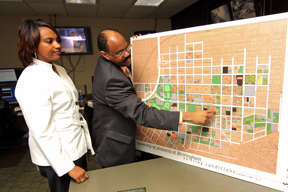UAB’s Police Department is the first university police force in Alabama accredited by the International Association of Campus Law Enforcement Administrators (IACLEA), signifying that it conforms to the highest professional standards for campus law enforcement and protective services.
 |
| UAB Police Sergeant Zandral Washington and Police Chief Anthony Purcell discuss a map of the campus. UAB Police units patrol more than 88 city blocks and nearly 13 million square feet of functional building space. |
“This is quite an honor, and it places us in elite company,” says UAB Police Chief Anthony Purcell. “I’m really pleased with the cooperation we received from our officers and professional staff to make this accreditation possible. It’s truly a team effort that comprises the work and dedication of our sworn and professional staff.”
The IACLEA accreditation follows the department’s three-year reaccreditation by the Commission on Accreditation for Law Enforcement Agencies (CALEA) this past summer. CALEA is an international accreditation program that sets the standards for police departments in the United States and Canada. Purcell and Zandral Washington, sergeant and accreditation manager for the department, recently have become certified CALEA assessors. They will travel to other states and assess departments seeking accreditation.
Only 5 percent, or about 760, law-enforcement agencies nationwide are accredited by CALEA.
Seeking accreditation
Accreditation from the agencies is voluntary, and it demands a great deal of detailed work to meet 460 standards for CALEA and 469 for IACLEA.
“You have to be 80 percent compliant with all of the standards to be accredited,” Washington says. “With CALEA, we were able to achieve a 98 percent compliance with the mandatory standards.”
Documentation of operations — including police reports, calls for services and programs provided by the department — have to be collected throughout the year from every unit in order to demonstrate compliance.
Purcell says meeting the standards is a challenge that’s important to the department because it shows the public, parents and the university community that UAB Police adheres to the highest professional standards and is committed to providing a safe and secure environment for all faculty, staff, students and visitors.
“It’s a lot of work,” Purcell says. “It takes dedication and commitment, and you have to want to do it.”
Help from other departments
The UABPD has more than 170 sworn and professional staff. Units patrol more than 88 city blocks, approximately 300 acres and 216 academic, residential and recreational buildings that translate into nearly 13 million square feet of functional building space.
The department provides numerous resources and ser-vices to campus to help maintain safety, including new student and employee orientations, emergency telephones, the UAB Escort Service and security surveys.
Purcell says other departments play a key role in safety. Parking and Transportation Services, Physical Security and Information Technology all played a key role in obtaining IACLEA accreditation.
“This cooperation among departments shows we have great relationships throughout campus,” she says.
UAB’s Police Department will do more in coming weeks to raise its level of visibility on campus. Officers use new T3 human transporters, motorcycles and bicycles in addition to their fleet of squad cars.
“Officers will be riding the T3s quite a bit during the evening hours while the students are out,” Washington says. “It’s another level of safety and appearance for the police department out in the community.”